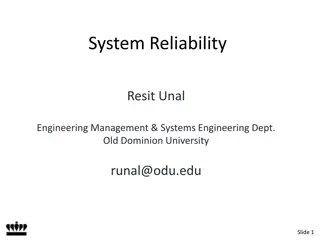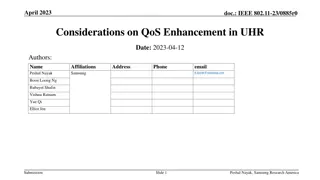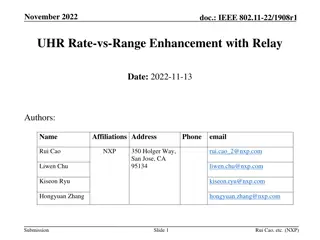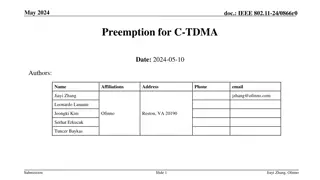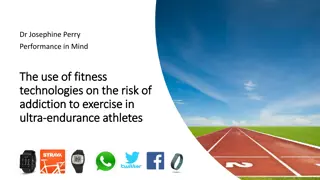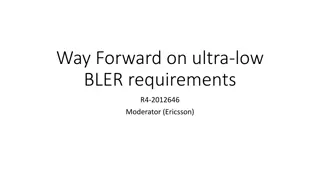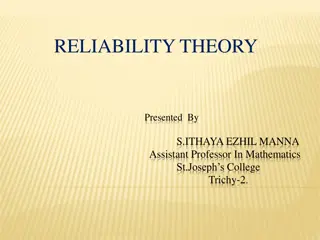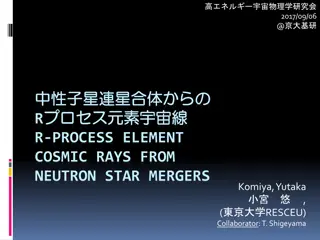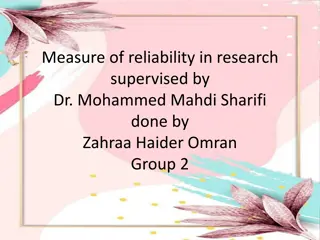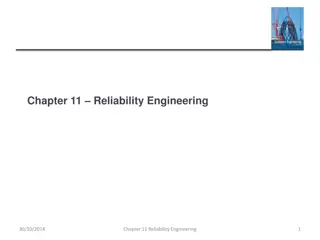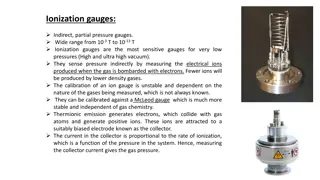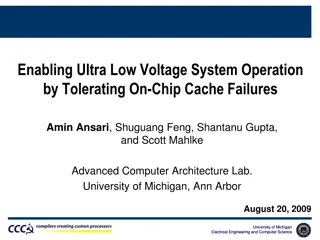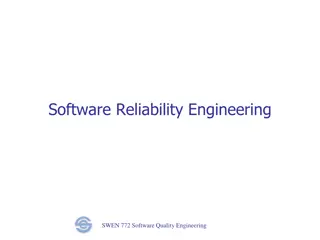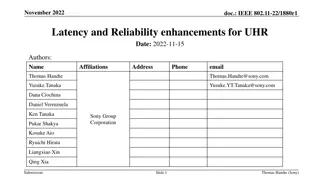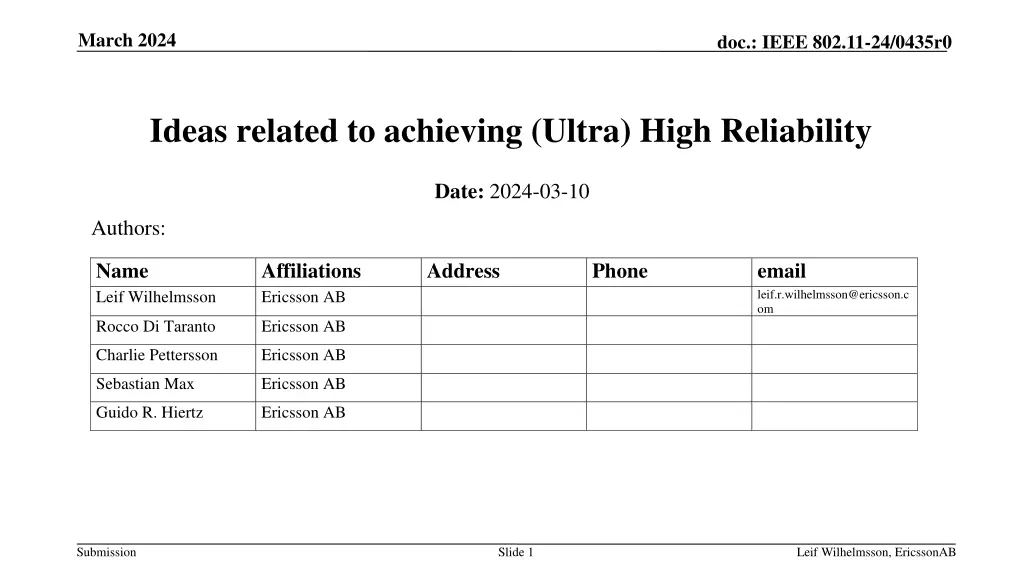
Achieving Ultra High Reliability in IEEE 802.11-24
Explore ideas and challenges related to achieving ultra high reliability in IEEE 802.11-24 for cutting-edge applications, emphasizing the importance of reliability over data rate, multi-layer transmission concepts, and addressing the need for low latency in high reliability communication scenarios.
Download Presentation

Please find below an Image/Link to download the presentation.
The content on the website is provided AS IS for your information and personal use only. It may not be sold, licensed, or shared on other websites without obtaining consent from the author. If you encounter any issues during the download, it is possible that the publisher has removed the file from their server.
You are allowed to download the files provided on this website for personal or commercial use, subject to the condition that they are used lawfully. All files are the property of their respective owners.
The content on the website is provided AS IS for your information and personal use only. It may not be sold, licensed, or shared on other websites without obtaining consent from the author.
E N D
Presentation Transcript
March 2024 doc.: IEEE 802.11-24/0435r0 Ideas related to achieving (Ultra) High Reliability Date: 2024-03-10 Authors: Name Leif Wilhelmsson Affiliations Ericsson AB Address Phone email leif.r.wilhelmsson@ericsson.c om Rocco Di Taranto Ericsson AB Charlie Pettersson Ericsson AB Sebastian Max Ericsson AB Guido R. Hiertz Ericsson AB Submission Slide 1 Leif Wilhelmsson, EricssonAB
March 2024 doc.: IEEE 802.11-24/0435r0 Outline Motivation and related work Challenges to achieve (ultra) high reliability Multi-layer transmission revisited Multi-layer transmission as an effective means to achieve high reliability What is required? Conclusions Submission Slide 2 Leif Wilhelmsson, EricssonAB
March 2024 doc.: IEEE 802.11-24/0435r0 Motivation and related work Although an increase in maximum data rate may be nice, what is believed to be more important is if a significant improvement in reliability could be achieved The name UHR suggests high reliability would be high on the agenda and the PAR [1] states Cutting-edge applications offer a wide range of digitally enhanced worlds, realities, and business models that have the potential to revolutionize both personal and enterprise activities in the next decade. These applications require large throughput combined with reduced and predictable worst- case delay and jitter, high reliability, and improved power efficiency. The reduced and predictable delay is partially addressed by improved channel access mechanisms, e.g., preemption. However, it typically (implicitly) assumes reliability since if one or more retransmissions are needed, the delay may neither be reduced nor predictable Submission Slide 3 Leif Wilhelmsson, EricssonAB
March 2024 doc.: IEEE 802.11-24/0435r0 Motivation and related work Multi-layer transmission was suggested also in [2][3], also targeting QoS enhancement and increased resilience to interference and by that being more suitable for some key applications of UHR: Beneficial to support different QoS for the same link, e.g. video with I and P frames Beneficial to e.g encode different 20 MHz part of an 80 MHz channel separately The idea being to support varying MCS for different frames or in case of MIMO using independent MCS on the different SS, or simply send multiple codewords in parallel over different 20 MHz parts of the total bandwidth The proposals have in common that they address different QoS and varying channel conditions in a way currently not supported in the specification Submission Slide 4 Leif Wilhelmsson, EricssonAB
March 2024 doc.: IEEE 802.11-24/0435r0 Challenges related to achieve high reliability Achieving Ultra High Reliability is typically not enough, the reliability must be achieved with low latency for the data to be useful Relying on retransmissions may not be attractive and maybe not even be an option for certain applications In 3GPP this is addressed by URLLC/HRLLC, targetingmission-critical applications such as factory automation, autonomous driving, and virtual/augmented reality UHR seems to pretty much target the same Operation in license-exempt bands adds yet another challenge In licensed bands the main issue is channel variations (fading) of the desired signal In license-exempt bands, the major cause for receiver condition variations may instead be interference The obvious approach to get higher reliability is to reduce the MCS This is OK if the data comes relatively seldom, but for continuous data high reliability then results in that the spectrum efficiency becomes very low The trade-off between reliability and high data rate is of course not new Submission Slide 5 Leif Wilhelmsson, EricssonAB
March 2024 doc.: IEEE 802.11-24/0435r0 Multi-layer transmission revisited In [4], the multi-layer concept was introduced as a means to improve the throughput for transmission over channels with unpredictable conditions When the variations are due to interference, LA cannot deal with the variations but instead the LA can select the optimum strategy for the expected (average) channel conditions In multi-layer transmission, effectively different codewords have different reliability. Some better and some worse than what is achieved with the usual single-layer approach Multi-layer transmission does therefore not require the TX to adapt to the channel conditions. The adaptation is essentially done at the RX The result is that one can use the channel in an opportunistic way, using a large MCS. If the channel does not allow for a large MCS, effectively the layers corresponding to a small MCS can still be correctly received In this way the average throughput was shown to improve for unpredictable channels Submission Slide 6 Leif Wilhelmsson, EricssonAB
March 2024 doc.: IEEE 802.11-24/0435r0 Multi-layer transmission revisited Data Data Preamble Preamble OFDM Symbols OFDM Symbols 1 0 0 0 1 0 0 0 1 1 0 1 1 1 0 1 The idea is to send a number of codewords in parallel, with different robustness, and decode as many as the channel conditions allow for Compared to the standard single layer approach, several layers with different reliabilities are used Submission Slide 7 Leif Wilhelmsson, EricssonAB
March 2024 doc.: IEEE 802.11-24/0435r0 Multi-layer transmission revisited In [5], the gains by using multi-layer transmission and/or HARQ were considered by means of system level simulations. Multi-layer transmission was found more effective than HARQ, and if combined even better performance was obtained Submission Slide 8 Leif Wilhelmsson, EricssonAB
March 2024 doc.: IEEE 802.11-24/0435r0 Numerical results: Assumptions To more easily appreciate the basic idea, the simulations are deliberately done for simple conditions AWGN channel Perfect channel knowledge at the receiver, no frequency offset, etc. No interleaving included Only results for the (1944,972) LDPC code are given Similar results seen for other LDPC codes BCC not simulated The decoding for the layers are done independently, no successive interference cancellation is applied Submission Slide 9 Leif Wilhelmsson, EricssonAB
March 2024 doc.: IEEE 802.11-24/0435r0 Multi-layer transmission for high reliability Consider 256-QAM and a rate r=1/2 LDPC (1944,972) code. The performance for bits 1-4 are shown (bits 5-8 have the same performance as 1-4 by I/Q symmetry). The performance ranges from 5.5-20.5 dB for CWER 10% To get intermediate performance, one can just use two or more bits as illustrated Using all eight bits give the ordinary single layer performance Submission Slide 10 Leif Wilhelmsson, EricssonAB
March 2024 doc.: IEEE 802.11-24/0435r0 Multi-layer transmission for high reliability: Example 1 Now, suppose the goal is to replace (enhance) the single layer transmission with a two-layer transmission with the same total data rate, but which has one layer with significantly improved reliability The natural choice to achieve this is as follows: Layer 1 uses only bit 1 Layer 2 uses bits 2+3+4+5+6+7+8 The result is: An increased robustness of roughly 10 dB for Layer 1 A loss of less than 1 dB for Layer 2 Submission Slide 11 Leif Wilhelmsson, EricssonAB
March 2024 doc.: IEEE 802.11-24/0435r0 Multi-layer transmission for high reliability: Example 2 The idea works in the same way also for MIMO. The bits for the different layers are selected among the different spatial streams To get the first layer as robust as possible, the most reliable bit from the best stream is selected In this example 4096-QAM &256-QAM are used Layer 1 uses only bit 1 in SS 1 Layer 2 uses bits 2 12 in SS1 + bits 1-8 in SS2 With UEQM, even less degradation of layer 2 compared to the single layer transmission is seen Submission Slide 12 Leif Wilhelmsson, EricssonAB
March 2024 doc.: IEEE 802.11-24/0435r0 Multi-layer transmission for high reliability: Remarks Using 1 or 2 bits for the most robust layer, this has similar performance independent of the used MCS The LA can be performed as usual for the high data rate layer The idea works for SISO/MIMO and unicast/broadcast transmissions It is noted that the loss because the most reliable bit(s) are not used for the high data rate layer is less than the gain of introducing UEQM => With UEQM and two layers, it is possible to support the same data rate as today and in addition support a layer with 10-20 dB improved robustness Submission Slide 13 Leif Wilhelmsson, EricssonAB
March 2024 doc.: IEEE 802.11-24/0435r0 What is required? The design is based on exploiting the Gray-mapping in the standard modulations, constructing the different reliability layers by combining suitable bits in the bit-to-symbol mapping No change of the modulator or demodulator It is suggested to use only the same encoder/decoder (rate and block size) for both layers No substantial gain expected by complicating things Since the codewords on the different layers are transmitted in parallel and the buffering is done for the high priority layer, At the TX side roughly one codeword (2kb) to be buffered At the RX side LLRs corresponding to one codeword (2kB) to be buffered The additional decoding delay is considered negligible Submission Slide 14 Leif Wilhelmsson, EricssonAB
March 2024 doc.: IEEE 802.11-24/0435r0 Conclusions It is expected that some highly relevant use cases for UHR would benefit from (or even require) some of the bits to be delivered with high reliability and low latency An approach for achieveing this is proposed, where the overall data rate is kept the same and the performance loss for the remaining bits is small Compared to other ways for achieving the same goal, the presented approach is believed to perform better and to require only relatively small changes (additions) to the PHY Submission Slide 15 Leif Wilhelmsson, EricssonAB
March 2024 doc.: IEEE 802.11-24/0435r0 Straw Poll 1 Do you believe that IEEE 802.11bn should consider multi-layer transmission as described in this presentation as a means to enhance the reliability? Submission Slide 16 Leif Wilhelmsson, EricssonAB
March 2024 doc.: IEEE 802.11-24/0435r0 References 1. https://mentor.ieee.org/802.11/dcn/23/11-23-1252-04-0uhr-802-11bn- revised-par.docx 2. https://mentor.ieee.org/802.11/dcn/22/11-22-1930-00-0uhr-layered-qos- and-multi-layer-transmision.pptx 3. https://mentor.ieee.org/802.11/dcn/23/11-23-0060-02-0uhr-layered-qos- and-multi-layer-transmission-follow-up.pptx 4. https://mentor.ieee.org/802.11/dcn/19/11-19-1133-00-00be-some-results-on- harq-performance-in-dense-deployments.ppt 5. https://mentor.ieee.org/802.11/dcn/19/11-19-1858-01-00be-harq-system- level-simulation-results.pptx Submission Slide 17 Leif Wilhelmsson, EricssonAB

